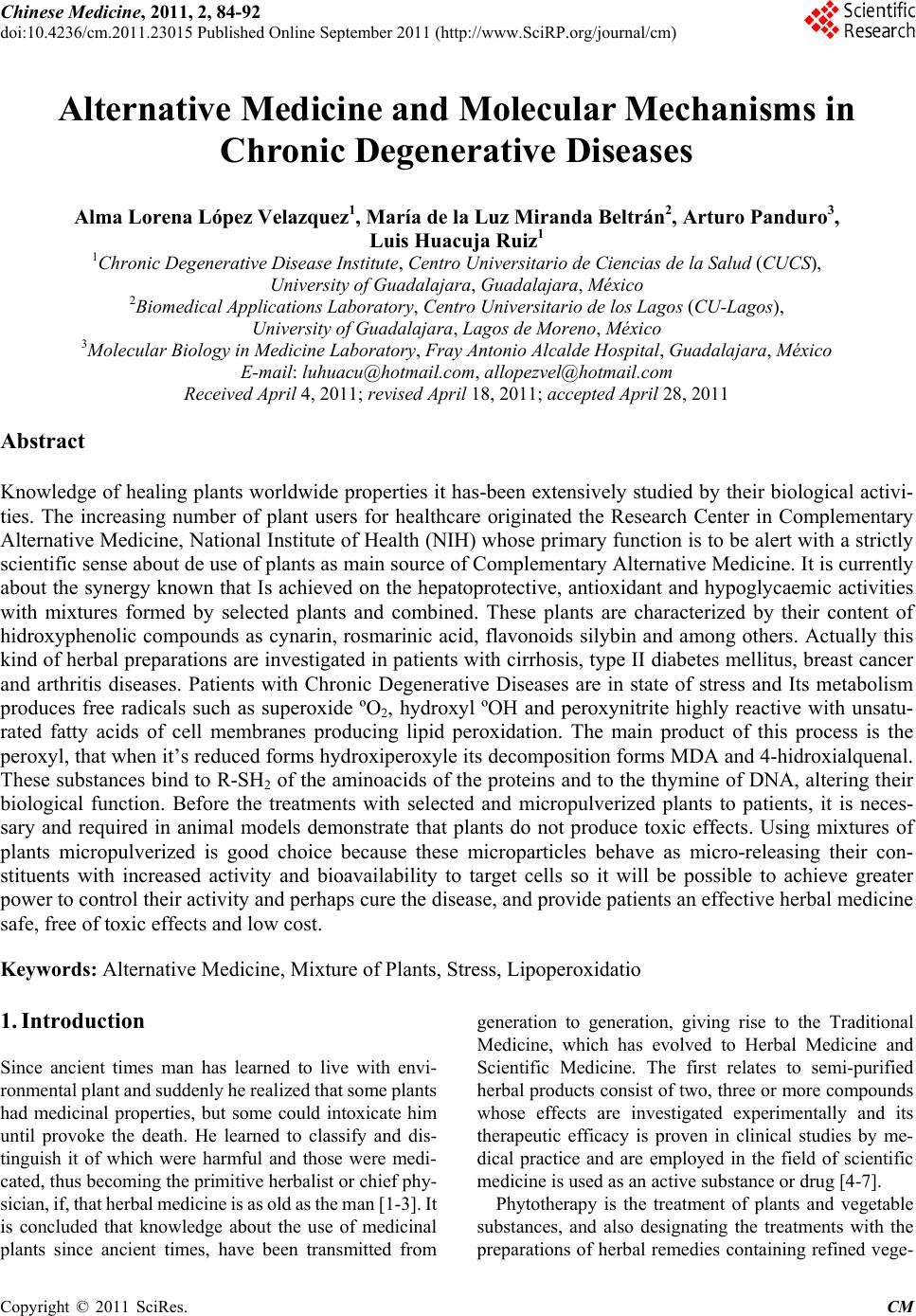 Chinese Medicine, 2011, 2, 84-92 doi:10.4236/cm.2011.23015 Published Online September 2011 (http://www.SciRP.org/journal/cm) Copyright © 2011 SciRes. CM Alternative Medicine and Molecular Mechanisms in Chronic Degenerative Diseases Alma Lorena López Velazquez1, María de la Luz Miranda Beltrán2, Arturo Panduro3, Luis Huacuja Ruiz1 1Chronic Degenerative Disease Institute, Centro Universitario de Ciencias de la Salud (CUCS), University of Guadalajara, Guadalajara, México 2Biomedical Applications Laboratory, Centro Universitario de los Lagos (CU-Lagos), University of Guadalajara, Lagos de Moreno, México 3Molecular Biology in Medicine Laboratory, Fray Antonio Alcalde Hospital, Guadalajara, México E-mail: luhuacu@hotmail.com, allopezvel@hotmail.com Received April 4, 2011; revised April 18, 2011; accepted April 28, 2011 Abstract Knowledge of healing plants worldwide properties it has-been extensively studied by their biological activi- ties. The increasing number of plant users for healthcare originated the Research Center in Complementary Alternative Medicine, National Institute of Health (NIH) whose primary function is to be alert with a strictly scientific sense about de use of plants as main source of Complementary Alternative Medicine. It is currently about the synergy known that Is achieved on the hepatoprotective, antioxidant and hypoglycaemic activities with mixtures formed by selected plants and combined. These plants are characterized by their content of hidroxyphenolic compounds as cynarin, rosmarinic acid, flavonoids silybin and among others. Actually this kind of herbal preparations are investigated in patients with cirrhosis, type II diabetes mellitus, breast cancer and arthritis diseases. Patients with Chronic Degenerative Diseases are in state of stress and Its metabolism produces free radicals such as superoxide ºO2, hydroxyl ºOH and peroxynitrite highly reactive with unsatu- rated fatty acids of cell membranes producing lipid peroxidation. The main product of this process is the peroxyl, that when it’s reduced forms hydroxiperoxyle its decomposition forms MDA and 4-hidroxialquenal. These substances bind to R-SH2 of the aminoacids of the proteins and to the thymine of DNA, altering their biological function. Before the treatments with selected and micropulverized plants to patients, it is neces- sary and required in animal models demonstrate that plants do not produce toxic effects. Using mixtures of plants micropulverized is good choice because these microparticles behave as micro-releasing their con- stituents with increased activity and bioavailability to target cells so it will be possible to achieve greater power to control their activity and perhaps cure the disease, and provide patients an effective herbal medicine safe, free of toxic effects and low cost. Keywords: Alternative Medicine, Mixture of Plants, Stress, Lipoperoxidatio 1. Introduction Since ancient times man has learned to live with envi- ronmenta l plant and s uddenl y he reali zed that some pl ants had medicinal properties, but some could intoxicate him until provoke the death. He learned to classify and dis- tinguish it of which were harmful and those were medi- cated, thus becoming th e pr imitive h erbalist o r chief ph y- sician, if, that herbal medicine is as old as the m an [1-3]. It is concluded that knowledge about the use of medicinal plants since ancient times, have been transmitted from generation to generation, giving rise to the Traditional Medicine, which has evolved to Herbal Medicine and Scientific Medicine. The first relates to semi-purified herbal products consist of two, three or more compounds whose effects are investigated experimentally and its therapeutic efficacy is proven in clinical studies by me- dical practice and are employed in the field of scientific medicine is used as an active substance or drug [4-7]. Phytotherapy is the treatment of plants and vegetable substances, and also designating the treatments with the preparations of herbal remedies containing refined vege- 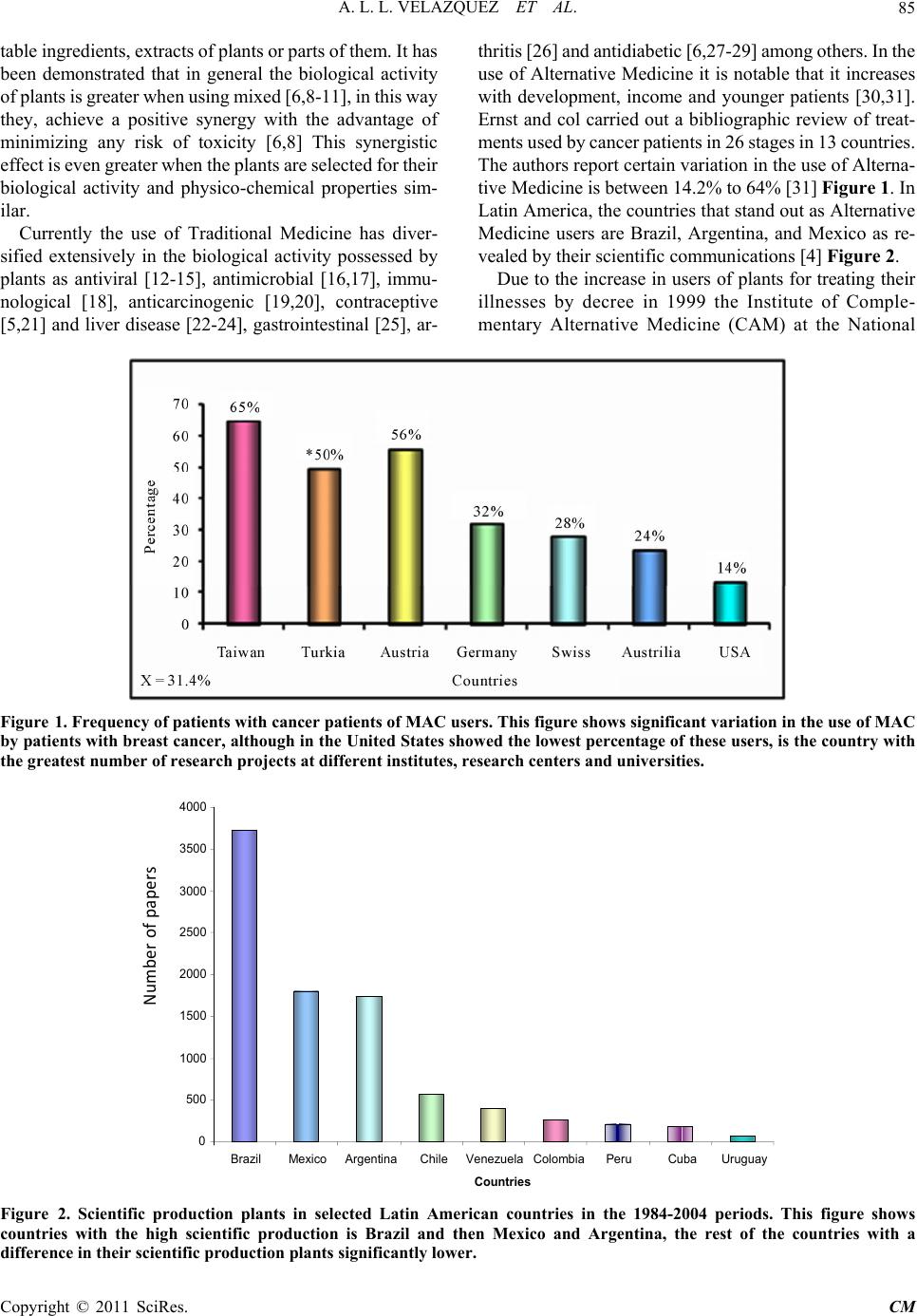 A. L. L. VELAZQUEZ ET AL.85 table ingredients, extracts of plants or parts of them. It has been demonstrated that in general the biological activity of plants is greater when using mi xed [6,8-11], in t his way they, achieve a positive synergy with the advantage of minimizing any risk of toxicity [6,8] This synergistic effect is even greater when the plants a re selected for their biological activity and physico-chemical properties sim- ilar. Currently the use of Traditional Medicine has diver- sified extensively in the biological activity possessed by plants as antiviral [12-15], antimicrobial [16,17], immu- nological [18], anticarcinogenic [19,20], contraceptive [5,21] and liver disease [22-24], gastrointestinal [25], ar- thritis [26] and antidiabetic [6,27-29] among others. In the use of Alternative Medicine it is n otable that it increases with development, income and younger patients [30,31]. Ernst and col carried out a bibliographic review of treat- ments used by cancer pat ients in 2 6 stages in 13 countries. The authors report certain variation in the use of Alterna- tive Medicine is between 14.2% to 64% [31] Figure 1. In Latin America, the countries that stand ou t as Alternative Medicine users are Brazil, Argentina, and Mexico as re- vealed by their scientific communications [4] Figure 2. Due to the increase in users of plan ts for treating their illnesses by decree in 1999 the Institute of Comple- mentary Alternative Medicine (CAM) at the National Figure 1. Frequency of patients with cancer patients of MAC users. This figure shows significant variation in the use of MAC by patients with breast cancer, although in the United States showed the lowest percentage of these users, is the country with the greatest number of research projects at different institutes, research centers and universities. 0 500 1000 1500 2000 2500 3000 3500 4000 Brazil Mexico rgentina ChileVenezuela Colombia PeruCuba Uruguay Count ries Numberofpapers Figure 2. Scientific production plants in selected Latin American countries in the 1984-2004 periods. This figure shows countries with the high scientific production is Brazil and then Mexico and Argentina, the rest of the countries with a difference in their scientific production plants significantly lower. Copyright © 2011 SciRes. CM 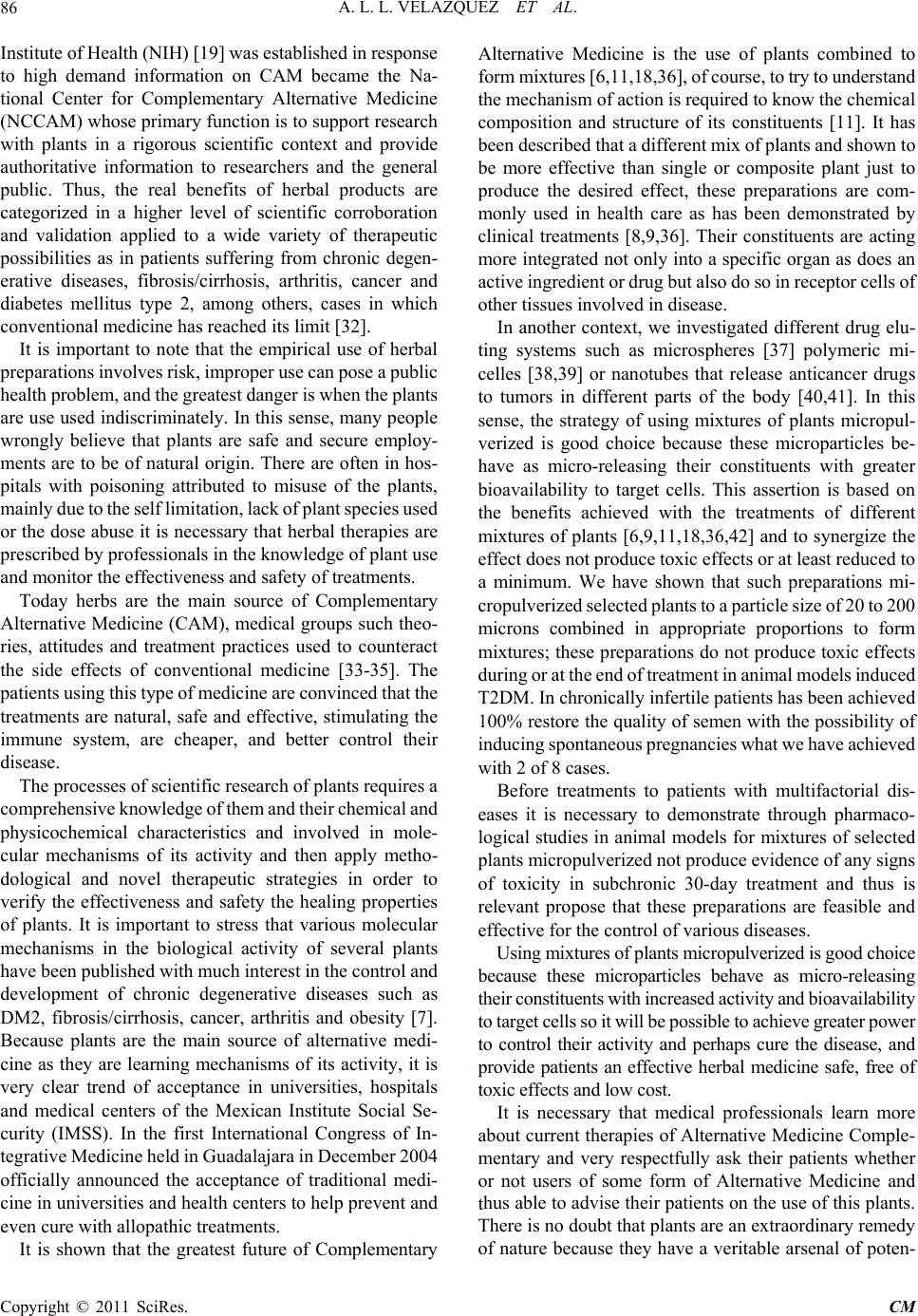 A. L. L. VELAZQUEZ ET AL. Copyright © 2011 SciRes. CM 86 Institute of Health (NIH) [19] was established in response to high demand information on CAM became the Na- tional Center for Complementary Alternative Medicine (NCCAM) whose primary function is to support research with plants in a rigorous scientific context and provide authoritative information to researchers and the general public. Thus, the real benefits of herbal products are categorized in a higher level of scientific corroboration and validation applied to a wide variety of therapeutic possibilities as in patients suffering from chronic degen- erative diseases, fibrosis/cirrhosis, arthritis, cancer and diabetes mellitus type 2, among others, cases in which conventional medicine has reached its limit [32]. It is important to note that the empirical use of herbal preparations involves risk, impro per use can pose a public health problem, and the greatest danger is when the plants are use used indiscriminately. In this sense, many people wrongly believe that plants are safe and secure employ- ments are to be of natural origin. There are often in hos- pitals with poisoning attributed to misuse of the plants, mainly due to the self limitation, lack of plant species used or the dose abuse it is necessary that herbal therapies are prescribed by professionals in the knowledge of plant use and monitor the effectiveness and safety of treatments. Today herbs are the main source of Complementary Alternative Medicine (CAM), medical groups such theo- ries, attitudes and treatment practices used to counteract the side effects of conventional medicine [33-35]. The patients using t his type of m edicine are c onvinced that t he treatments are natural, safe and effective, stimulating the immune system, are cheaper, and better control their disease. The processes of scientific research of plants requires a comprehensive knowledge of them and their chem ical and physicochemical characteristics and involved in mole- cular mechanisms of its activity and then apply metho- dological and novel therapeutic strategies in order to verify the effectiveness and safety the healing properties of plants. It is important to stress that various molecular mechanisms in the biological activity of several plants have been pu bl ished with much intere st in t he co ntrol a n d development of chronic degenerative diseases such as DM2, fibrosis/cirrhosis, cancer, arthritis and obesity [7]. Because plants are the main source of alternative medi- cine as they are learning mechanisms of its activity, it is very clear trend of acceptance in universities, hospitals and medical centers of the Mexican Institute Social Se- curity (IMSS). In the first International Congress of In- tegrative Medicine held in Guadalajara in December 2004 officially announced the acceptance of traditional medi- cine in universities and health cen ters to he lp preven t and even cure with allopathic treatments. It is shown that the greatest future of Complementary Alternative Medicine is the use of plants combined to form mixt ures [6,11,18,36], of course, to try t o understand the mecha nism of act i on i s re qui re d t o know the chemical composition and structure of its constituents [11]. It has been described that a different mix of plants and shown to be more effective than single or composite plant just to produce the desired effect, these preparations are com- monly used in health care as has been demonstrated by clinical treatments [8,9,36]. Their constituents are acting more integrated not only into a specific organ as does an active ingredient or drug but also do so in receptor cells of other tissues involved in disease. In another context, we investigated different drug elu- ting systems such as microspheres [37] polymeric mi- celles [38,39] or nanotubes that release anticancer drugs to tumors in different parts of the body [40,41]. In this sense, the strategy of using mixtures of plants micropul- verized is good choice because these microparticles be- have as micro-releasing their constituents with greater bioavailability to target cells. This assertion is based on the benefits achieved with the treatments of different mixtures of plants [6,9,11,18,36,42] and to synergize the effect does not pr oduce to xic e ffects or at lea st reduced to a minimum. We have shown that such preparations mi- cropulverized selected plants to a pa rticle size of 20 t o 200 microns combined in appropriate proportions to form mixtures; these preparations do not produce toxic effects during or at the end of treatment in anim al models induced T2DM. In chronically infertile patients has been achieved 100% restore the quality of se men with the possibility of inducing spontaneous pregnancies what we have ac hieved with 2 of 8 cases. Before treatments to patients with multifactorial dis- eases it is necessary to demonstrate through pharmaco- logical studies in animal models for mixtures of selected plants micropulverized not produce evidence of any signs of toxicity in subchronic 30-day treatment and thus is relevant propose that these preparations are feasible and effective for the control of various diseases. Using mixtures of plants mi cropulverized is good choice because these microparticles behave as micro-releasing their constituents with increased activity and bioavailability to target cells so it will be possible to achieve greater power to control their activity and perhaps cure the disease, and provide patients an effective herbal medicine safe, free of toxic effects and low cost. It is necessary that medical professionals learn more about current therapies of Alternative Med icine Comple- mentary and very respectfully ask their patients whether or not users of some form of Alternative Medicine and thus able to advise their patients on the use of this plants. There is no doubt that plants are an extraordinary remedy of nature because they have a veritable arsenal of poten- 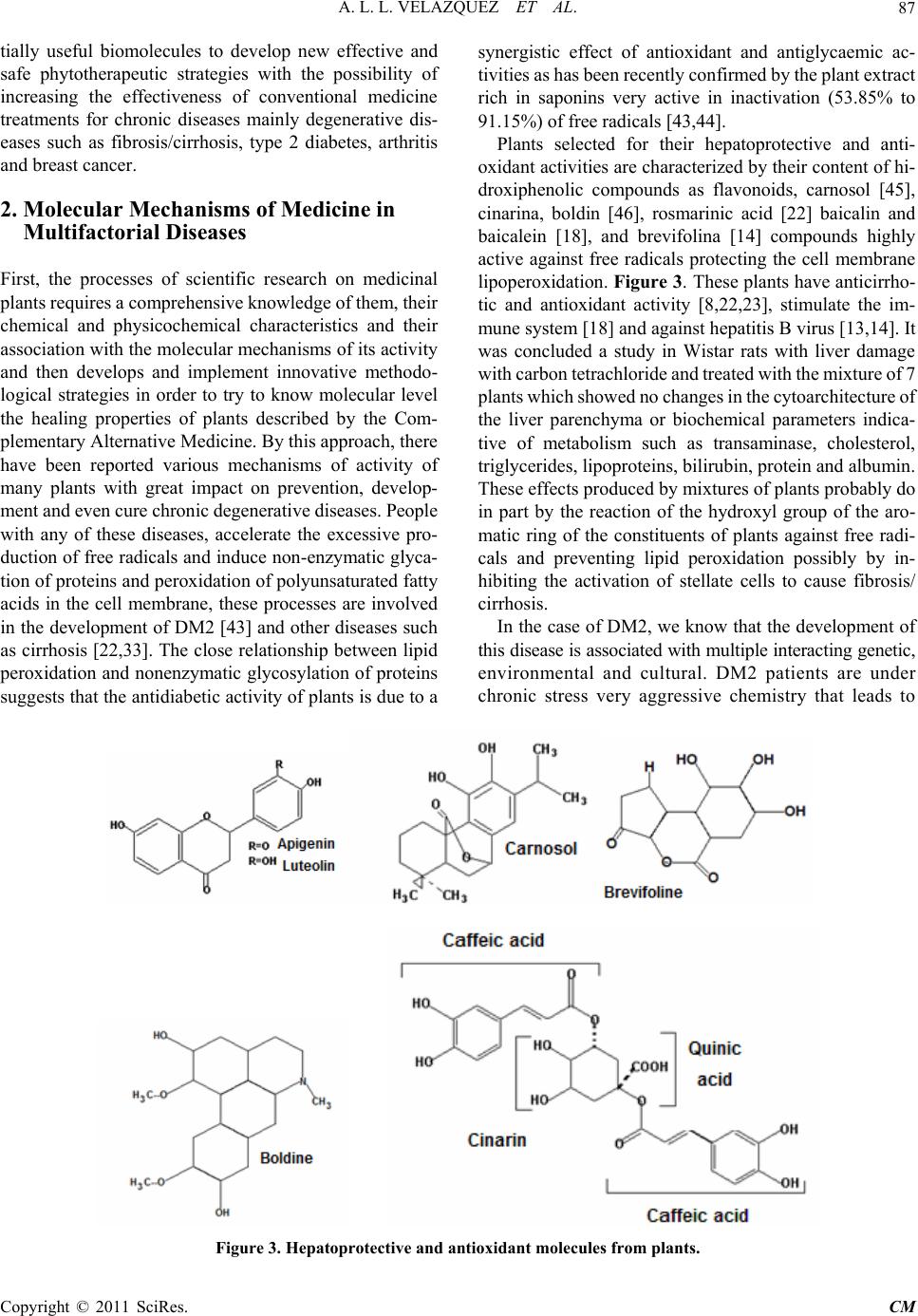 A. L. L. VELAZQUEZ ET AL.87 tially useful biomolecules to develop new effective and safe phytotherapeutic strategies with the possibility of increasing the effectiveness of conventional medicine treatments for chronic diseases mainly degenerative dis- eases such as fibrosis/cirrhosis, type 2 diabetes, arthritis and breast cancer. 2. Molecular Mechanisms of Medicine in Multifactorial Diseases First, the processes of scientific research on medicinal plants requires a comprehe nsi ve knowledg e of them , their chemical and physicochemical characteristics and their association with the molecular mechanisms of its activity and then develops and implement innovative methodo- logical strategies in order to try to know molecular level the healing properties of plants described by the Com- plementary Alternative Medicine. By this approach, there have been reported various mechanisms of activity of many plants with great impact on prevention, develop- ment and eve n cur e ch ronic de gene rative dise ases. Peopl e with any of these diseases, accelerate the excessive pro- duction of free rad icals and induce non-enzymatic glyca- tion of proteins and peroxidation of polyunsaturated fatty acids in the cell membrane, these processes are involved in the development of DM2 [43] and other diseases such as cirrhosis [22,33]. The close relationship between lipid peroxidation and nonenzymatic glycosylation of proteins suggests that the antidiab etic activity of p lants is due to a synergistic effect of antioxidant and antiglycaemic ac- tivities as has been recently confirmed by the plant extract rich in saponins very active in inactivation (53.85% to 91.15%) of free radicals [43,44]. Plants selected for their hepatoprotective and anti- oxidant activities are characterized by their conten t of hi- droxiphenolic compounds as flavonoids, carnosol [45], cinarina, boldin [46], rosmarinic acid [22] baicalin and baicalein [18], and brevifolina [14] compounds highly active against free radicals protecting the cell membrane lipoperoxidation. Figure 3. These plants have anticirrho- tic and antioxidant activity [8,22,23], stimulate the im- mune system [18] and against hepatitis B virus [13,14]. It was concluded a study in Wistar rats with liver damage with carbon tetrachloride and treated with the mixture of 7 plants which showed no changes in the cytoarchitecture of the liver parenchyma or biochemical parameters indica- tive of metabolism such as transaminase, cholesterol, triglycerides, lipoproteins, bilirubin, protein and albu min. These effects produced by mixtures of plants pr o bably do in part by the reaction of the hydroxyl group of the aro- matic ring of the constituents of plants against free radi- cals and preventing lipid peroxidation possibly by in- hibiting the activation of stellate cells to cause fibrosis/ cirrhosis. In the case of DM2, we know that the development of this disease is associa ted with multiple int eracting genetic, environmental and cultural. DM2 patients are under chronic stress very aggressive chemistry that leads to Figure 3. Hepatoprotective and antioxidant molecules from plants. Copyright © 2011 SciRes. CM 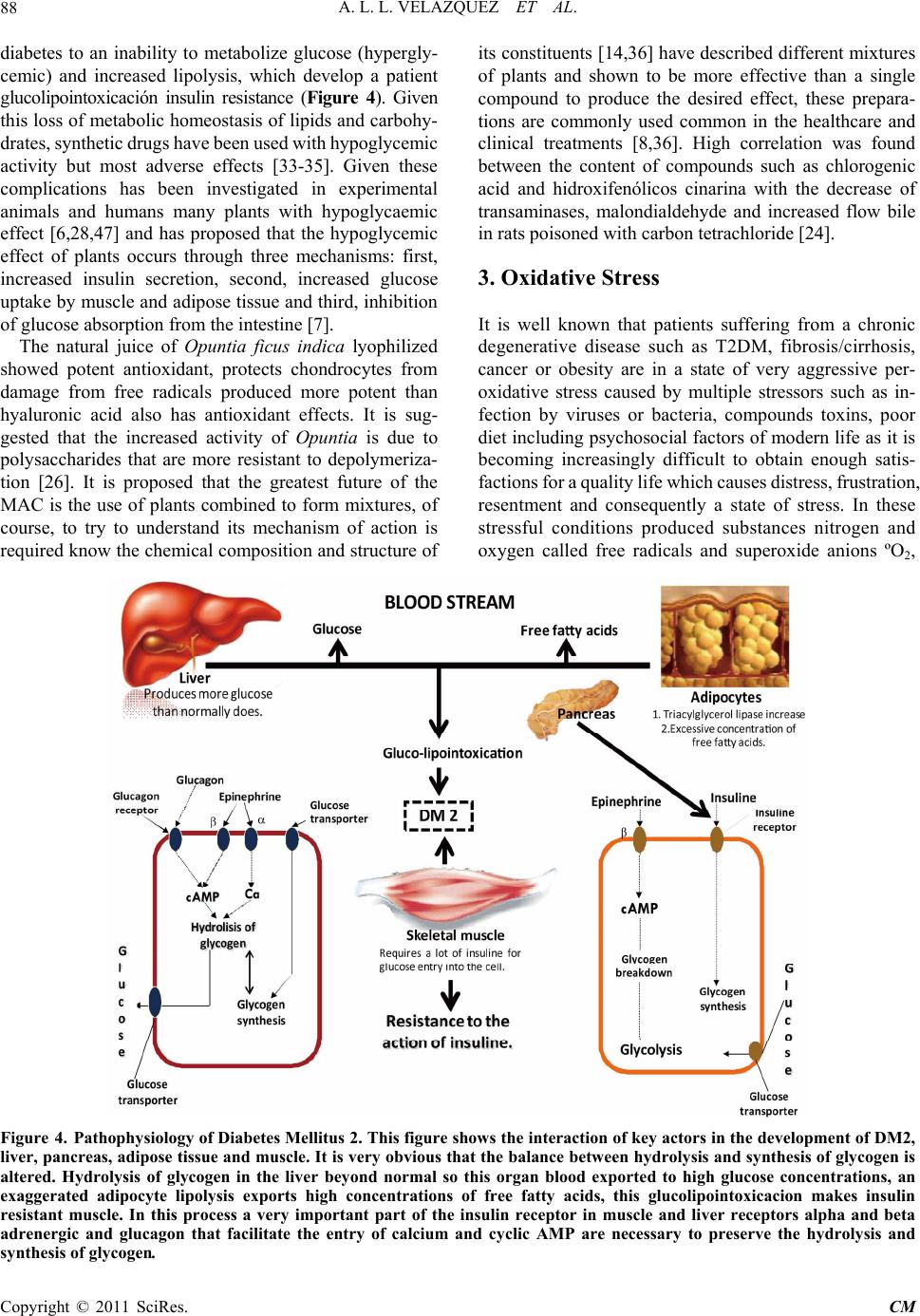 A. L. L. VELAZQUEZ ET AL. Copyright © 2011 SciRes. CM 88 diabetes to an inability to metabolize glucose (hypergly- cemic) and increased lipolysis, which develop a patient glucolipointoxicación insulin resistance (Figure 4). Given this loss of metabolic homeostasis of lipids and carbohy- drates, synthet ic drugs have been used wit h hypoglycemic activity but most adverse effects [33-35]. Given these complications has been investigated in experimental animals and humans many plants with hypoglycaemic effect [6,28,47] and has proposed that the hypoglycemic effect of plants occurs through three mechanisms: first, increased insulin secretion, second, increased glucose uptake by muscle and adipose tissue an d third, inhibition of glucose absorption from the intestine [7]. The natural juice of Opuntia ficus indica lyophilized showed potent antioxidant, protects chondrocytes from damage from free radicals produced more potent than hyaluronic acid also has antioxidant effects. It is sug- gested that the increased activity of Opuntia is due to polysaccharides that are more resistant to depolymeriza- tion [26]. It is proposed that the greatest future of the MAC is the use of plants combined to form mixtures, of course, to try to understand its mechanism of action is required know the chemical composition and structure of its constituents [14,36] have described different mixtures of plants and shown to be more effective than a single compound to produce the desired effect, these prepara- tions are commonly used common in the healthcare and clinical treatments [8,36]. High correlation was found between the content of compounds such as chlorogenic acid and hidroxifenólicos cinarina with the decrease of transaminases, malondialdehyde and increased flow bile in rats poisoned with carbon tetrachloride [24]. 3. Oxidative Stress It is well known that patients suffering from a chronic degenerative disease such as T2DM, fibrosis/cirrhosis, cancer or obesity are in a state of very aggressive per- oxidative stress caused by multiple stressors such as in- fection by viruses or bacteria, compounds toxins, poor diet including psychosocial factors of modern life as it is becoming increasingly difficult to obtain enough satis- factions for a quality life which causes distress, frustration, resentment and consequently a state of stress. In these stressful conditions produced substances nitrogen and oxygen called free radicals and superoxide anions ºO2, Figure 4. Pathophysiology of Diabetes Mellitus 2. This figure shows the interaction of key actors in the development of DM2, liver, pancreas, adipose tissue and muscle. It is very obvious that the balance between hydr olysis and synthesis of glycogen is altered. Hydrolysis of glycogen in the liver beyond normal so this organ blood exported to high glucose concentrations, an exaggerated adipocyte lipolysis exports high concentrations of free fatty acids, this glucolipointoxicacion makes insulin resistant muscle. In this process a very important part of the insulin receptor in muscle and liver receptors alpha and beta adrenergic and glucagon that facilitate the entry of calcium and cyclic AMP are necessary to preserve the hydrolysis and synthesis of glycogen.  A. L. L. VELAZQUEZ ET AL. Copyright © 2011 SciRes. CM 89 hydroxyl ºOH, NO peroxynitrite ºONO2, nitroxyl RNOº, phenoxyl, alcohoxile RCO, peroxyl RCOOº the among other highly reactive polyunsaturated fatty acids in the membranes of cel ls producing the per oxyl radical pri mary product of l ipid per oxidation in the pre sence of a red ucing agent as hydroperoxide [48] whose decomposition gives rise to mal ondialdehyde and 4 hy droxy alquenal, Fi gure 5, that bind to RSH2 of the amino acids in prote ins and D NA thymine which metal ions (trace elements) can lead to mutations [49]. When agents are an intense impact stressors and chronic natural antioxidant defenses of our body such as glutathione, vitamin E and superoxide dismutase are not able to neutralize excess free radicals as cell membranes are damaged severely. Oxidative stress can be measured by enzyme superoxide dismutase (SOD), lipoperoxidase (LP), uric acid and malondialdehyde (MDA) the major molecular markers of oxidative stress [50]. The antioxi- dant propert i es o f u ri c aci d have been st udi ed recentl y , it s plasma concentration is 10 times greater than vitamins E and C [51], its soluble form in plasma urate, captures the radical superoxide (ºO2), hydroxyl radical (H Oº), inhibits Figure 5. Lipoperoxidation of polyunsaturated fatty acids. The lipid peroxidation process involving free radicals super- oxide (2) and hydroxyl (OHº) this by reacting with the poly-insaturated fatty acid, lose a hydrogen atom in the presence of •OH radical produce a water and lipid radical. The main product of these process is the peroxyl that when its reduced forms hydroperoxyle, its decomposition forms malondial- dehyde and 4 hydroxialquenal. These substances are very reactives with R-SH2 of proteins and with DNA thymine. o O the reaction of nitric oxide (NO) with O2 and prevents the formation of highly toxic peroxynitrite causes cell dam- age by nitration tyrosine residues of proteins. Uric acid, helps maintain normal levels of NO and endothelial function t o pre vent de gradat i on of t he enzy m e sup er oxi de dismutase extracellular enzyme that is essential in main- taining vascular en dothelial function. Oxidative stress induces excessive entry of free fatty acids to the liver where it is stored as triglycerides. This accumulation of lipids in the liver, the mitochondria con- tribute to losing the ability to oxidize fatty acids by β oxidation and transported to the cytoplasm. In these cir- cumstances the liver key organ in maintaining homeosta- sis, has transformed liver fat and there is a pathophysio- logical state known as steatohepatitis that develops fi- brosis/cirrhosis and consequently the altered metabolism in peripheral organs: muscle, brain, heart, kidney and pancreas. 4. Discussion To investigate the activity of a more comprehensive mix seemingly more difficult than when investigating an ac- tive substance or drug. However , this difficulty is partially resolved by the engagement of researchers bound in their respective areas of expertise assigned to different research centers and institutes and thus to ensure the feasibility of meeting the targets committed to projects resulting from the research. This criterion is necessary and required to perform more comprehensive investigation with the mixture of plants through two stages of research: the first basic research in animal models to demonstrate through pharmacological studies of acute and chronic sub 30 days that the mix of plants non-lethal effects or toxicity at the therapeutic dose given to continue the second phase of research in patients with clinical diagnosis of the disease. In conducting research in this manner, it is possible to scientifically validate the healing properties of plants of Traditional Medicine are potentially useful for effective and safe herbal therapies with significant impact on ap- plied research. Of course, this implies strong support for the institutions co ncerned to promote the develop ment of substantive programs that allow plants to obtain optimum crop quality in sufficient quantities and at appropriate times. Also promote the linking programs with health institutions to shape its application in clinical research projects and marketing to reach prospective new phy- tomedicines. Sinergistic effect is even greater when the plants are selected for their biological activity and phy- siochemical similar properties. Since we now are getting to know the molecular me- chanisms of activity of the plants investigated indi- vidually or combined to form blends achieved a syner- 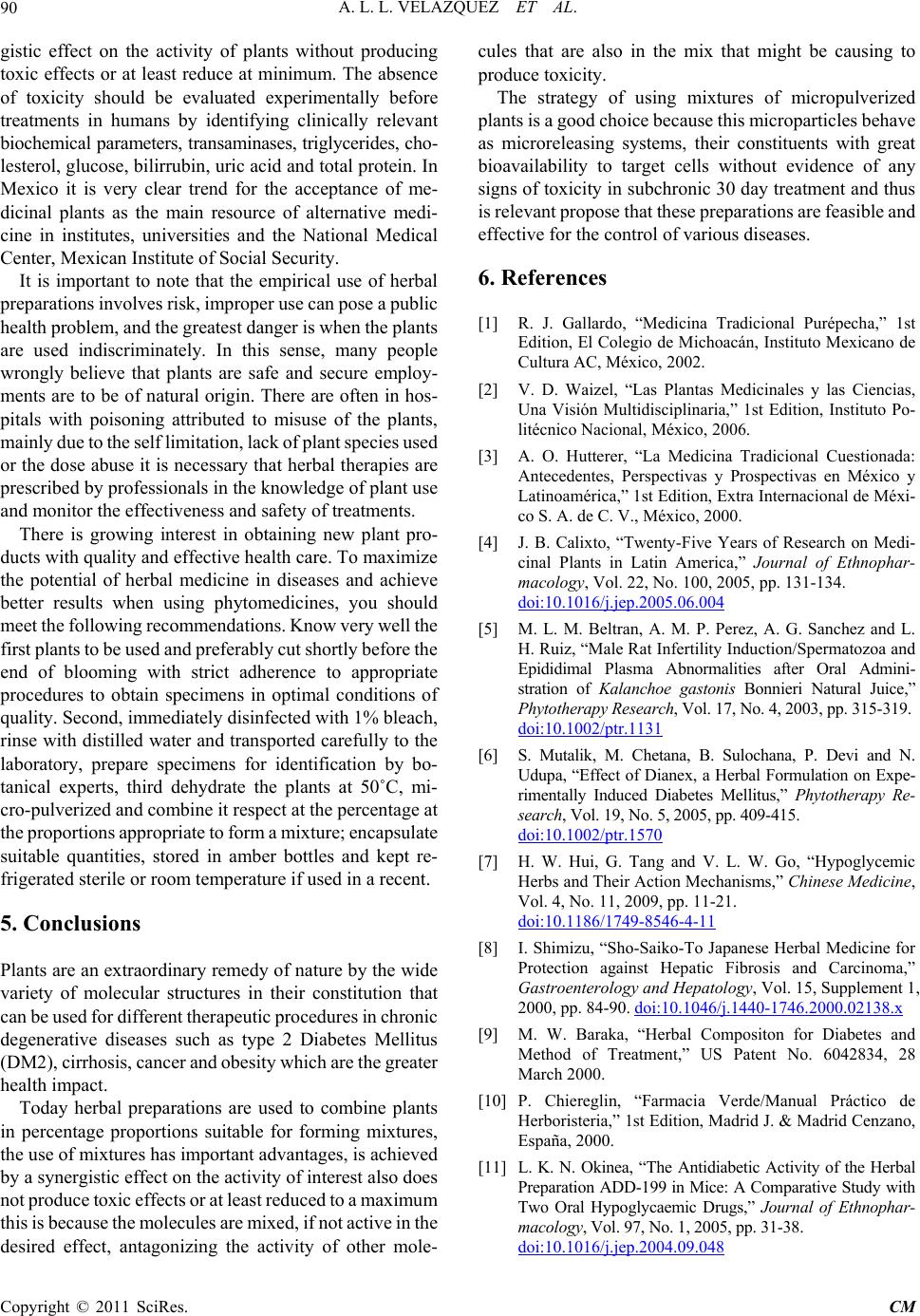 A. L. L. VELAZQUEZ ET AL. 90 gistic effect on the activity of plants without producing toxic effects or at least reduce at minimum. The absence of toxicity should be evaluated experimentally before treatments in humans by identifying clinically relevant biochemical parameters, transaminases, triglycerides, cho- lesterol, glucose, bilirrubin, uric acid and total pro tein. In Mexico it is very clear trend for the acceptance of me- dicinal plants as the main resource of alternative medi- cine in institutes, universities and the National Medical Center, Mexican Institute of Social Security. It is important to note that the empirical use of herbal preparations involves risk, impro per use can pose a public health problem, and the greatest danger is when the plants are used indiscriminately. In this sense, many people wrongly believe that plants are safe and secure employ- ments are to be of natural origin. There are often in hos- pitals with poisoning attributed to misuse of the plants, mainly due to the self limitation, lack of plant species used or the dose abuse it is necessary that herbal therapies are prescribed by professionals in the knowledge of plant use and monitor the effectiveness and safety of treatments. There is growing interest in obtaining new plant pro- ducts with quality and effective health care. To maximize the potential of herbal medicine in diseases and achieve better results when using phytomedicines, you should meet the following recommendations. Know very well the first plants to be used and preferably cut shortly before the end of blooming with strict adherence to appropriate procedures to obtain specimens in optimal conditions of quality. Second, immediately disinfected with 1% bleach, rinse with distilled water and transported carefu lly to the laboratory, prepare specimens for identification by bo- tanical experts, third dehydrate the plants at 50˚C, mi- cro-pulverized and combine it res pect at the percentage at the proportions appropriate to form a mixture; encapsulate suitable quantities, stored in amber bottles and kept re- frigerated sterile or room temperature if used in a recent. 5. Conclusions Plants are an extraordinary remedy of nature by the wide variety of molecular structures in their constitution that can be used for different therapeutic proce dures in chronic degenerative diseases such as type 2 Diabetes Mellitus (DM2), cirrh osis, cancer and obesity which a re the greater health impact. Today herbal preparations are used to combine plants in percentage proportions suitable for forming mixtures, the use of mixtures has important advantages, is achieved by a synergistic effect on the activity of interest also does not prod uce toxic effects o r at least reduced t o a maximum this is because the molecules are mixed, if not active in the desired effect, antagonizing the activity of other mole- cules that are also in the mix that might be causing to produce toxicity. The strategy of using mixtures of micropulverized plants is a goo d choice becau se this micropa rticles beha ve as microreleasing systems, their constituents with great bioavailability to target cells without evidence of any signs of toxicity in subchronic 30 day treatment and thus is relevant propose that t hese preparations are feasible and effective for the control of various diseases. 6. References [1] R. J. Gallardo, “Medicina Tradicional Purépecha,” 1st Edition, El Colegio de Michoacán, Instituto Mexicano de Cultura AC, México, 2002. [2] V. D. Waizel, “Las Plantas Medicinales y las Ciencias, Una Visión Multidisciplinaria,” 1st Edition, Instituto Po- litécnico Nacional, México, 2006. [3] A. O. Hutterer, “La Medicina Tradicional Cuestionada: Antecedentes, Perspectivas y Prospectivas en México y Latinoamérica,” 1st Edition, Extra Internacional de Méxi- co S. A. de C. V., México, 2000. [4] J. B. Calixto, “Twenty-Five Years of Research on Medi- cinal Plants in Latin America,” Journal of Ethnophar- macology, Vol. 22, No. 100, 2005, pp. 131-134. doi:10.1016/j.jep.2005.06.004 [5] M. L. M. Beltran, A. M. P. Perez, A. G. Sanchez and L. H. Ruiz, “Male Rat Infertility Induction/Spermatozoa and Epididimal Plasma Abnormalities after Oral Admini- stration of Kalanchoe gastonis Bonnieri Natural Juice,” Phytotherapy Research, Vol. 17, No. 4, 2003, pp. 315-319. doi:10.1002/ptr.1131 [6] S. Mutalik, M. Chetana, B. Sulochana, P. Devi and N. Udupa, “Effect of Dianex, a Herbal Formulation on Expe- rimentally Induced Diabetes Mellitus,” Phytotherapy Re- search, Vol. 19, No. 5, 2005, pp. 409-415. doi:10.1002/ptr.1570 [7] H. W. Hui, G. Tang and V. L. W. Go, “Hypoglycemic Herbs and Their Action Mechanisms,” Chinese Medicine, Vol. 4, No. 11, 2009, pp. 11-21. doi:10.1186/1749-8546-4-11 [8] I. Shimizu, “Sho-Saiko-To Japanese He rbal Medicine for Protection against Hepatic Fibrosis and Carcinoma,” Gastroenterology and Hepatology, Vol. 15, Supplement 1, 2000, pp. 84-90. doi:10.1046/j.1440-1746.2000.02138.x [9] M. W. Baraka, “Herbal Compositon for Diabetes and Method of Treatment,” US Patent No. 6042834, 28 March 2000. [10] P. Chiereglin, “Farmacia Verde/Manual Práctico de Herboristeria,” 1st Edition, Madrid J. & Madrid Cenzano, España, 2000. [11] L. K. N. Okinea, “The Antidiabetic Activity of the Herbal Preparation ADD-199 in Mice: A Comparative Study with Two Oral Hypoglycaemic Drugs,” Journal of Ethnophar- macology, Vol. 97, No. 1, 2005, pp. 31-38. doi:10.1016/j.jep.2004.09.048 Copyright © 2011 SciRes. CM  A. L. L. VELAZQUEZ ET AL.91 [12] K. T. Leung, C. M. Lawrence and M. Chiu, “In Vitro Antiviral Chinese Medicinal Herbs against Duck Hepa- titis B Virus,” Phytotherapy Research, Vol. 20, No. 10, 2006, pp. 911-914. doi:10.1002/ptr.1969 [13] R. L. Huacuja, V. A. L. López, A. Panduro, P. Mondragón and B. M. L. Miranda, “Fitoterapia de la Hepatitis Airal B Crónica,” Investigación en Salud, Vol. 9, No. 3, 2007, pp. 190-197. [14] R.-L. Huang, Y.-L. Huang, J.-C. Ou, C.-C. Chen, F.-L. Hsu and C. M. Chang, “Screening of 25 Compounds Isolated from Phyllanthus Species for Antihuman Hepa- titis B Virus in Vitro,” Phytotherapy Research, Vol. 17, No. 5, 2003, pp. 449-453. doi:10.1002/ptr.1167 [15] G.-B. Yao, “Treatment of Chronic Hepatitis B in China,” Journal of Gastroenterology and Hepatology, Vol. 15, Supplement 2, 2000, pp. E61-E66. doi:10.1046/j.1440-1746.2000.02106.x [16] T. Mangena and N. Y. O. Muyima, “Comparative Eva- luation of the Antimicrobial Activities of Essential Oil of Artemisa afra, Pteronia incana y Rosmarinus officinalis in Selected Bacteria and Yeast Strains,” Letters in Applied Microbiology, Vol. 28, No. 4, 1999, pp. 291-296. doi:10.1046/j.1365-2672.1999.00525.x [17] G. Rojas, J. Levaro and V. Tortoriello Navarro, “Anti- microbial Evaluation of Certain Plants Used in Mexican Traditional Medicine for the Treatment of Respiratory Diseases,” Journal of Ethnopharmacology, Vol. 74, No. 1, 2001, pp. 97-101. doi:10.1016/S0378-8741(00)00349-4 [18] A. T. Borchers, S. Sakay , G. L. Henderson, M. R. Harkey, C. L. Keen, J. S. Stern, K. Terasawa and M. E. Gershwin, “Shosaiko-To and Other Kampo (Japanese Herbal) Medi- cines: A Review of Their In munomodulatory Acti- vities,” Journal of Ethnopharmacology, Vol. 73, No. 1-2, 2000, pp. 1-13. doi:10.1016/S0378-8741(00)00334-2 [19] M. K. Canales and B. M. Ge ller, “Surviving Breast Cancer. The Role of Complementary Therapies,” Community Health, Vol. 26, No. 1, 2003, pp. 11-24. [20] S. Gozum, A. Tezel and M. Koc, “Complementary Alter- native Treatments Used by Patients with Cancer in East- ern Turkey,” Cancer Nursing, Vol. 26, No. 3, 2003, pp. 230-236. doi:10.1097/00002820-200306000-00010 [21] L. Huacuja, A. M. Puebla, A. Carranco, M. L. Miranda, H. Merchant, A. Reyes and A. Guzman, “Contraceptive Effect on Male Rats after Administration of Kalanchoe blossfeldiana Crassulaceae Plant Aqueous Crude Extract,” Advanced Contraceptive Delivery Systems, Vol. 13, No. 1, 1997, pp. 13-21. [22] B. M. L. Miranda, R. L. Huacuja, V. A. L. López and A. Panduro, “Fitoterapia Molecular Como Parte de la Me- dicina Alternativa Complementaria en las Enfer-Medades del Hígado,” Investigación en Salud, Vol. 7, 2005, pp. 64-70. [23] R. Misha and O. Cohen, “Herbal Complementary and Alternative Medicine Therapies for Liver Disease,” Clini- cal in Liver Disease, Vol. 5, No. 2, 2001, pp. 461-468. [24] E. Speroni, R. Cervelallati and P. Govoni, “Efficacy of Different Cynara scolymus Preparations on Liver Com- plains,” Journal of Ethnopharmacology, Vol. 86, No. 2-3, 2003, pp. 203-211. doi:10.1016/S0378-8741(03)00076-X [25] G. Shcmeda-Hirschmann and Y. Erdem, “Traditional Medicine and Gastroprotective Crude Drugs,” Journal of Ethnopharmacology, Vol. 100, No. 1-2, 2005, pp. 61-66. doi:10.1016/j.jep.2005.06.002 [26] A. M. Panico, V. Carkile and Y. Garuti, “Effect of Hya- luronic Acid and Polysacarides from Opuntia ficus indica (L) Cladodes on the Metabolism of Human Chondrocyte Cultures,” Journal of Ethnopharmacology, Vol. 111, No. 2, 2007, pp. 315-321. doi:10.1016/j.jep.2006.11.020 [27] H.-P. Guan, Y. Li, M. V. Jensen, C. B. Newgard, C. M. Steppan and M. A. Lazar, “A Futile Metabolic Cycle Activated in Adipocytes by Antidiabetic Agents,” Nature Medicine, Vol. 8, No. 10, 2002, pp. 1122-1128. doi:10.1038/nm780 [28] W. L. Li, H. C. Zheng, J. Bukuru and N. De Kimpe, “Natural Medicines Used in the Traditional Chinese Me- dical System for Therapy of Diabetes Mellitus,” Journal of Ethnopharmacology, Vol. 94, No. 1, 2004, pp. 1-21. doi:10.1016/j.jep.2003.12.031 [29] V. Vats, J. K. Grover and S. S. Rathi, “Evaluation of Anti-Hyperglycemic and Hypoglucemic Effect of Trigo- nella foenum-graecum Lin, Ocinum sanctum Lin and Pterocarpus marsupium in Normal and Alloxanized Dia- betics Rats,” Journal of Ethnopharmacology, Vol. 79, No. 1, 2002, pp. 95-100. doi:10.1016/S0378-8741(01)00374-9 [30] S. M. Downer, M. M. Cody and P. McCluskey, “Pursuit and Practice of Complementary Therapies by Cancer Patients Receiving Conventional Treatment,” British Me- dical Journal, Vol. 309, 1994, pp. 86-89. [31] E. Ernst and S. R. Casillech, “The Prevalence of Com- plementary/Alternative Medicine in Cancer: A Syste- matic Review,” Cancer, Vol. 8, No. 4, 1998, pp. 10-15. [32] A. Y. Oubre, T. J. Carlson, S. R. King and G. M. Reaven, “From Plant to Patient and Ethnomedical Approach to the Identification of New Drugs for the Treatment of NIDDM,” Diabetologia, Vol. 40, No. 5, 1997, pp. 614- 617. [33] S. E. Inzuchi, “Oral Antihyperglycemic Therapy for Type 2 Diabetes/Scientific Review,” The Journal of the Ame- rican Medical Association, Vol. 287, No. 3, 2002, pp. 360-372. [34] N. Morral, “Novel Targets and Therapeutic Strategies for Type 2 Diabetes,” Trends in Endocrinology and Meta- bolism, Vol. 14, No. 4, 2003, pp. 169-175. doi:10.1016/S1043-2760(03)00031-6 [35] L. D. May, J. H. Leftorowitch M. T. Kram and D. E. Rubin, “Mixed Hepatocelular Cholestatic Liver Injury after Pioglitazone Therapy,” Annals of Internal Medicine, Vol. 136, No. 6, 2002, pp. 449-452. [36] J. Lieu, “Oleanolic Acid: Research Perspectives,” Journal of Ethnopharmacology, Vol. 100, No. 1-2, 2005, pp. 92-94. doi:10.1016/j.jep.2005.05.024 [37] A. Matzumoto, Y. Matsukawa and T. Suzuki, “The Poly- mer Allows Method as a New Preparation Method of Biodegradable Microspheres: Principle and Applications Copyright © 2011 SciRes. CM 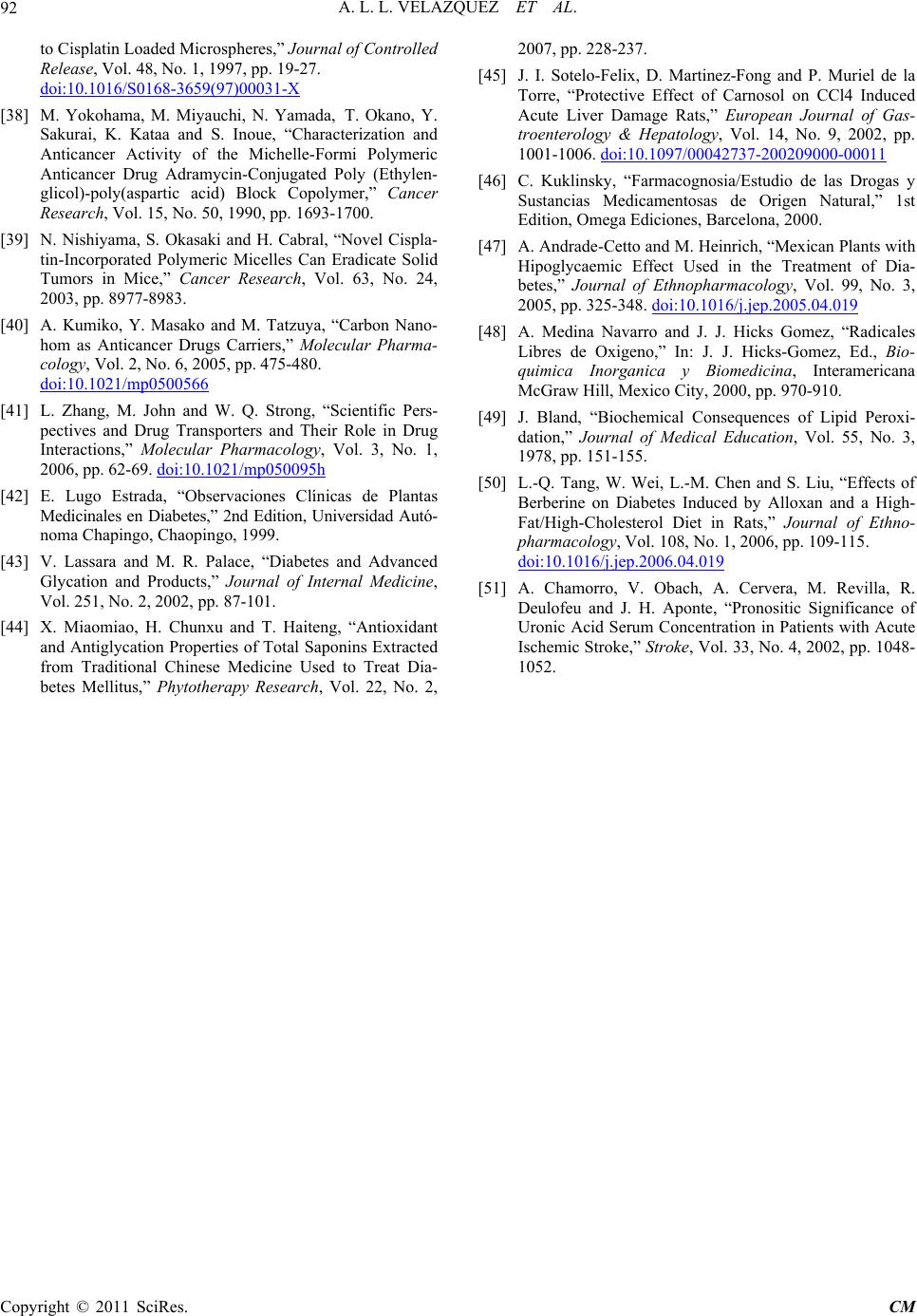 A. L. L. VELAZQUEZ ET AL. Copyright © 2011 SciRes. CM 92 to Cisplatin Loaded Microspheres,” Journal of Controlled Release, Vol. 48, No. 1, 1997, pp. 19-27. doi:10.1016/S0168-3659(97)00031-X [38] M. Yokohama, M. Miyauchi, N. Yamada, T. Okano, Y. Sakurai, K. Kataa and S. Inoue, “Characterization and Anticancer Activity of the Michelle-Formi Polymeric Anticancer Drug Adramycin-Conjugated Poly (Ethylen- glicol)-poly(aspartic acid) Block Copolymer,” Cancer Research, Vol. 15, No. 50, 1990, pp. 1693-1700. [39] N. Nishiyama, S. Okasaki and H. Cabral, “Novel Cispla- tin-Incorporated Polymeric Micelles Can Eradicate Solid Tumors in Mice,” Cancer Research, Vol. 63, No. 24, 2003, pp. 8977-8983. [40] A. Kumiko, Y. Masako and M. Tatzuya, “Carbon Nano- hom as Anticancer Drugs Carriers,” Molecular Pharma- cology, Vol. 2, No. 6, 2005, pp. 475-480. doi:10.1021/mp0500566 [41] L. Zhang, M. John and W. Q. Strong, “Scientific Pers- pectives and Drug Transporters and Their Role in Drug Interactions,” Molecular Pharmacology, Vol. 3, No. 1, 2006, pp. 62-69. doi:10.1021/mp050095h [42] E. Lugo Estrada, “Observaciones Clínicas de Plantas Medicinales en Diabetes,” 2nd Edition, Universidad Autó- noma Chapingo, Chaopingo, 1999. [43] V. Lassara and M. R. Palace, “Diabetes and Advanced Glycation and Products,” Journal of Internal Medicine, Vol. 251, No. 2, 2002, pp. 87-101. [44] X. Miaomiao, H. Chunxu and T. Haiteng, “Antioxidant and Antiglycation Properties of Total Saponins Extracted from Traditional Chinese Medicine Used to Treat Dia- betes Mellitus,” Phytotherapy Research, Vol. 22, No. 2, 2007, pp. 228-237. [45] J. I. Sotelo-Felix, D. Martinez-Fong and P. Muriel de la Torre, “Protective Effect of Carnosol on CCl4 Induced Acute Liver Damage Rats,” European Journal of Gas- troenterology & Hepatology, Vol. 14, No. 9, 2002, pp. 1001-1006. doi:10.1097/00042737-200209000-00011 [46] C. Kuklinsky, “Farmacognosia/Estudio de las Drogas y Sustancias Medicamentosas de Origen Natural,” 1st Edition, Omega Ediciones, Barcelona, 2000. [47] A. Andrade-Cetto and M. Heinrich, “Mexican Plants with Hipoglycaemic Effect Used in the Treatment of Dia- betes,” Journal of Ethnopharmacology, Vol. 99, No. 3, 2005, pp. 325-348. doi:10.1016/j.jep.2005.04.019 [48] A. Medina Navarro and J. J. Hicks Gomez, “Radicales Libres de Oxigeno,” In: J. J. Hicks-Gomez, Ed., Bio- quimica Inorganica y Biomedicina, Interamericana McGraw Hill, Mexico City, 2000, pp. 970-910. [49] J. Bland, “Biochemical Consequences of Lipid Peroxi- dation,” Journal of Medical Education, Vol. 55, No. 3, 1978, pp. 151-155. [50] L.-Q. Tang, W. Wei, L.-M. Chen and S. Liu, “Effects of Berberine on Diabetes Induced by Alloxan and a High- Fat/High-Cholesterol Diet in Rats,” Journal of Ethno- pharmacology, Vol. 108, No. 1, 2006, pp. 109-115. doi:10.1016/j.jep.2006.04.019 [51] A. Chamorro, V. Obach, A. Cervera, M. Revilla, R. Deulofeu and J. H. Aponte, “Pronositic Significance of Uronic Acid Serum Concentration in Patients with Acute Ischemic Stroke,” Stroke, Vol. 33, No. 4, 2002, pp. 1048- 1052.
|